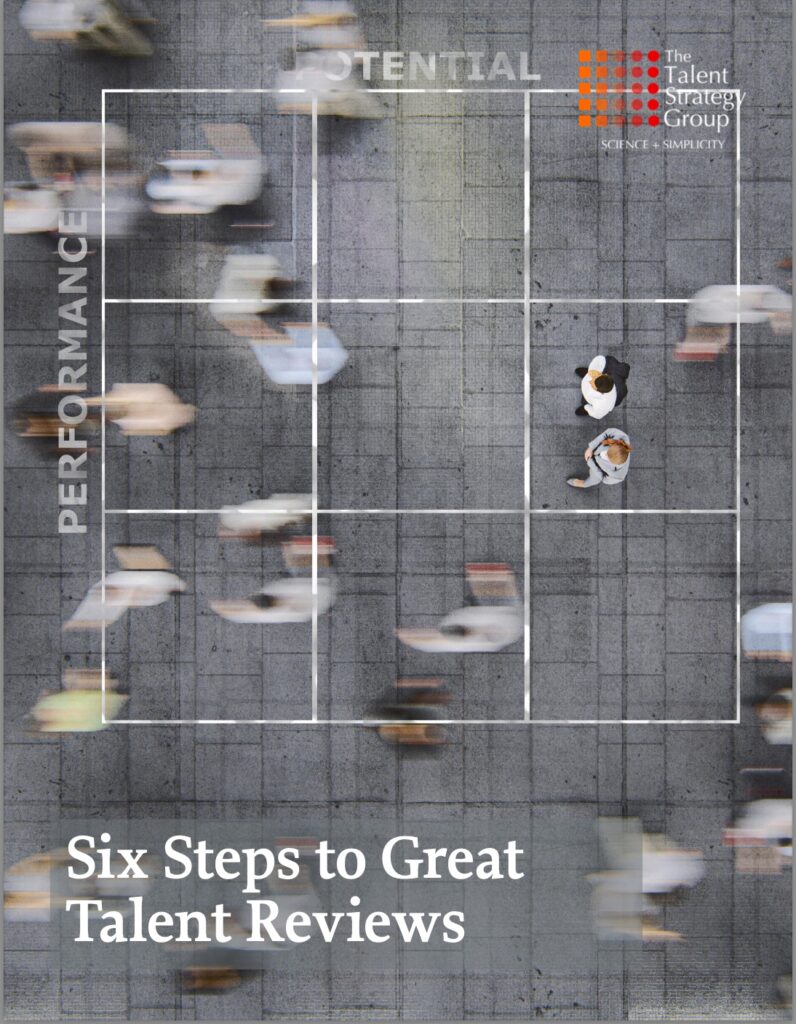Please enter your email in order to download this publication.
A People Manager’s Guide
If you believe that better quality talent delivers better results, then you should want as much great talent on your team as quickly as you can get it. A well-run talent review is the surest, shortest path to make that happen.
Unfortunately, leaders don’t always get the benefits they should from talent reviews. Leaders are full of good ideas and positive intentions for their talent, but that doesn’t mean that they accurately evaluate them or follow up on the development promises they made in the review.
We want you to be the best talent-building leader possible, so we share below four talent review secrets and three tips that will get you more better talent faster.
Secret #1: High performance is not high potential
Perhaps the largest mistake managers make during talent reviews is to confuse an individual’s high performance with their having high potential to advance. It’s an understandable error but one that results in far too many people being inaccurately labeled as high potential.
In reality, there’s a largely one-way relationship between those two things. While nearly every true high potential is also a high performer, very few high performers have high potential. That relationship exists for a few reasons:
- Potential means up: The primary purpose of talent reviews is to predict how far and how fast someone can move up into a larger, more complex role. Potential must be defined in this way – it’s not just being able to do more in your current role. The ability to grow in one’s role should be an expectation of anyone in any role – it doesn’t suggest someone has potential.
- Different skills are needed: It’s a common experience that people are promoted to their level of incompetence. That happens when we don’t realize that different capabilities are required to win on each step up the ladder.
The classic example is promoting a shoe store’s best salesperson to be the shoe store manager. Even though the manager role might only be one step above the salesperson, the roles have almost nothing in common. In that case, you’ve mistaken high performance for high potential.
That’s also why focusing on your strengths is a poor strategy if you plan to move up. You’ll need very different skills as you move up and earlier strengths might undercut your success in different and larger challenges.
- Your organization is a pyramid: A very practical reason why performance does not equal potential is that you likely work in a pyramid-shaped organization. There are fewer directors than managers, fewer vice presidents than directors, etc. This means that even if everyone is a high performer (they’re not), only 1 in 5 or 8 or 10 people at any level can move up and then only when a role becomes available.
In your talent review, ask yourself whether the person being discussed has outperformed 3 out of 4 of their peers, on average, over the past 3 years. If so, they’re a high performer and now qualify to be evaluated for their potential and interest in moving up.
If you’re advocating high potential status for someone who doesn’t meet that standard, you’ll need to have a strong argument. If someone has only been an average performer in their current job, why would you believe that they’ll succeed in an even larger and more challenging job?
#2: Potential = Person + Situation
A talent review’s purpose is to differentiate people based on potential – their ability and desire to contribute more. Unfortunately, the science about human potential is incomplete.
There’s agreement about the few big factors that contribute to potential but even with that information we know only about 50% -60% of what makes someone high potential for any given job. What we do know is enough to be relatively accurate in predicting potential if the best possible definition is combined with a well-run talent review process.
What you should know about potential is that it’s a combination of person and situation. People succeed when they bring the capabilities to a situation that’s needed at that moment. This means that potential is more than just being a smart, hard-working, ambitious and likable person. Not everyone with those characteristics succeeds in every situation. In fact, leaders like that fail every day in big important jobs.
About the situation: In our Talent Management Institute at the University of North Carolina, we teach that “companies change faster than leaders do.” This means that companies move through a life-cycle where what they need from talent changes in various phases. The better the leader fits with the company’s needs in that phase, the more potential they’ll be seen to have.
The leader who excelled in an entrepreneurial company might be frustrated at new processes and perceived bureaucracy as that company matures. The turnaround leader who succeeded because of a ruthless focus on cost might be seen as not having the right investment philosophy when the company needs to innovate.
In each example, the person’s personal characteristics haven’t changed but the situation in which they need to apply them has.
In your talent review, ask yourself what are the few differentiating capabilities that your company needs to win going forward. Do you predict that the talent you’re discussing will be a perfect fit, a good fit or not a great fit with those capabilities? (For a deeper explanation, please read our article, “Companies Change Faster than Leaders Do”)
About the individual: An individual brings both “born” and “made” capabilities to your evaluation of potential. The most predictive ones for you to consider are:
- Applied intelligence: A person’s intelligence is the single largest predictor of their ability to be a high performer or a high potential at work. This is applied intelligence, not IQ, so you want to evaluate how someone demonstrates intelligence at work.
In the talent review, ask yourself can this person quickly process large amounts of information to arrive at sound decisions? Do they ask smartly critical questions about a topic? Do they make complex concepts simple?
- Proven capabilities: Past performance doesn’t predict future success in a different activity. But, if someone has a strong history of top-tier performance across a variety of big, different, challenging experiences, it’s an excellent indicator that they can deliver similar results if you put them into more experiences like those.
In the talent review, ask yourself if this person has consistently succeeded in every challenging experience where they’ve been asked to perform at a high level.
- Upward ambition: Not everyone wants to move up but that’s part of the definition of high potential. Ambition is the state of wanting to do, prove and get more. The best way to assess this is to ask your team member if they’re up for the larger challenges, risks and rewards they’ll face a layer or two above where they are today.
In the talent review, ask yourself if you’re clear about your team member’s ambition and what drives it.
Overall, in your talent review ask yourself if you understand your company’s future capability needs, your team members’ intelligence, experiences and ambition, and how well the two fit together. Don’t say, “they’re high potential but just not in the way you define it.”
#3: Focus on the talent review discussion, not the tools
Your company might use the classic 9-box grid with performance assessed on one side and potential to advance assessed on the other. Originated years ago by either McKinsey or GE (depending on the storyteller), the grid is intended to separate the discussion of performance from the discussion of potential. That’s a valuable purpose (to our discussion in Secret #1) but the number of boxes isn’t the point – the discussion is.
We’ve seen 4-box grids, 5-boxes, 6-boxes and even 28-boxes. Any tool that helps separate the discussion of performance from potential is helpful. The most important question is what criteria you’re using to evaluate potential. Charting someone on a 9-box is just the outcome of the high-quality conversation you’ve had about their potential.
In the talent review, do place people in the boxes or categories provided and have very solid facts to back up your placement. In the talent review, don’t complain about the tools being used or attempt to redesign them on the spot. Your company’s tool is what you’re asked to use. Don’t engage in false precision by saying things like, “Well they’re in this box but at the top of it.”
#4: Build talent faster through experiences.
A key mantra in the science of human development is “70/20/10.” That ratio tells us that about 70% of what we learn comes from our professional experiences (jobs, projects, etc.), about 20% comes by learning through others (i.e. shadowing someone, getting feedback) and about 10% comes from formal learning and education.
So, you’ll want to consider experiences first when you think through how to accelerate the development of your best talent. What experiences will most quickly accelerate them from where they are today to the place you (and they) want them to go?
To answer those questions you need to have a point of view about which experiences matter most and if there’s an order in which people need to get them. Coach from that point of view.
In the talent review, ask yourself if every high potential and high performer has an experienced-based development plan focused on the one experience that will most accelerate their growth.
Three tips
We mentioned earlier that talent reviews don’t always produce the great outcomes they should. These three practical tips will help ensure that you get all the talent-building power possible from this process.
1. Follow-through. Talent reviews help you to grow people faster by accurately evaluating them and then developing them based on your evaluation. The only purpose of evaluating them is to develop them, so following through is essential to build better talent faster. A few easy ways to ensure you to that:
-
- Use the talent review to crowdsource high potential’s development plans. If the group has just discussed Suzie’s strengths, weaknesses and goals, share your suggested development action for Suzie with the group and ask if they have better ideas about how to accelerate her development. You’ll get good ideas and suggestions and earn their support for Suzie’s eventual development plan.
- Follow up in your team meeting. You likely have a weekly, monthly or quarterly team meeting. Use that to track your direct reports’ follow up on the development commitments they made in their talent review about their team.
- Report up to your manager. Share monthly with your manager the progress that your high potential or high performing leaders are making on their development plans.
2. Do realistic succession planning. A succession plan is a risk mitigation plan for your business. It gives leaders above you confidence that there won’t be a performance gap in your group if a key player moves. Your plan must be realistic, not optimistic, about who will be ready for what roles by what time.
Those on the plan should be in the high potential category on your performance and potential matrix. If they aren’t, it suggests that you’re saying that average talent should be promoted into larger, more impactful roles.
It’s better to turn in a blank succession chart and ask your boss and HR for support in building your team’s bench-strength, than to list names that will never be actual successors.
3. Be largely transparent. “Should we tell a high po that they’re a high po?” Companies have been asking that question for at least 50 years and they’re still struggling with what their policy should be. We’re fans of transparency and suggest the following approach:
-
- After the talent review, meet with everyone discussed and share a summary of the discussion with them. This doesn’t mean that you necessarily have to tell people that they are in a certain box or category. But our standard of transparency is that, if you place a 9-box grid (or whatever you use) in front of the employee at the end of the conversation and ask them to make an “x” in the box you just discussed, they can accurately do that.
- Tell high potentials that they are high potentials. You can use that term or a different one. You can tell them that they can move “far and fast in the organization.” But let them know that the organization highly values them and will be investing in their success. Also let them know that potential is something to be realized, so it’s up to them to prove their ability over the next few years.
- Tell successors that they may be successors. No, you are not promising them a role and they should understand that. Let them know that they are one person (perhaps among many others) who is being considered as potentially moving into role “x” in “y” number of years. Be clear that to be considered for the role they must show continued strong growth and high performance. Share that this is a potential opportunity and not a guaranteed one.
Yeah, but . . .
- Isn’t it HR’s job to assess talent? No, it’s your job as a manager to assess your team members’ capabilities. You work with your team every day so you should have a fact-based point of view about how far and fast each of them can move. HR should provide you with tools, training and processes to do this. Trust us that HR isn’t hiding some secret, more accurate assessment process that only they know how to use.
- Shouldn’t we use assessments to more accurately measure potential? Assessments should be used if they will provide you with information that you don’t already have about the potential criteria described in #2 above. If someone has been on your team for 2 – 3 years, you should already accurately know their ambition, their experiences, if they have enough cognitive capability and how they’ve performed in experiences you’ve given them.
You may not know how others (peers, direct reports, other leaders) perceive them, so a 360- assessment can be helpful in that situation. If they’re new to your team, they and you might benefit from a “derailer” assessment. But, in most cases, assessments are not going to provide much practical information beyond what you already know about an individual’s potential.
- Isn’t training important for development too? Refer to our 70/20/10 rule. Yes, training matters but too often it’s the default solution used by managers. Your first instinct to develop your team member should be to identify the best next experience for them. Training should be used when there’s no way to develop the needed capabilities in-house.
We know that better talent delivers better results, so use your valuable time to grow your team in the fastest, most effective way. Follow your company’s talent review process and be sure to apply the four secrets (and three tips) for the best possible results!




